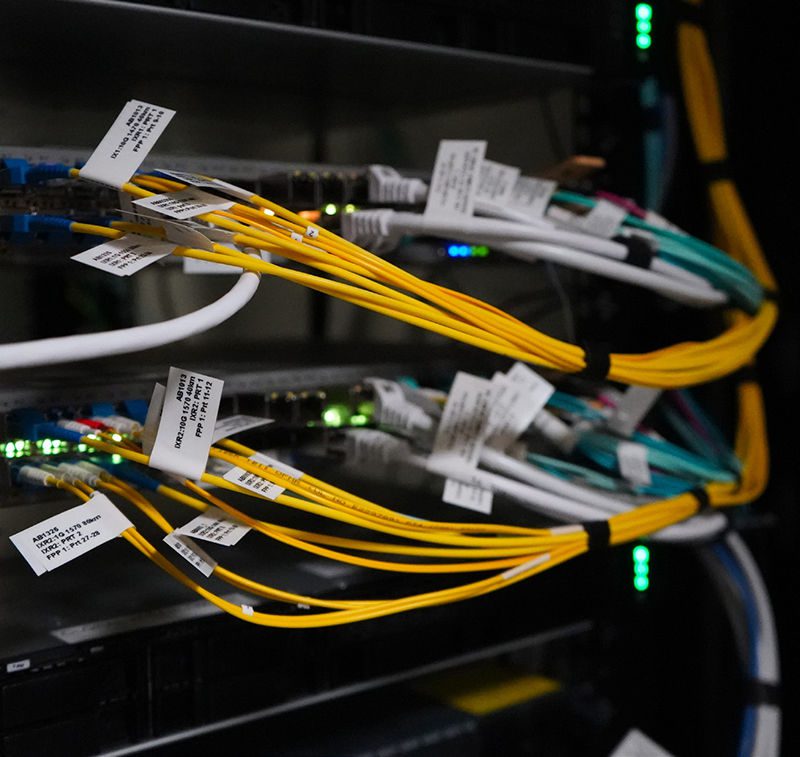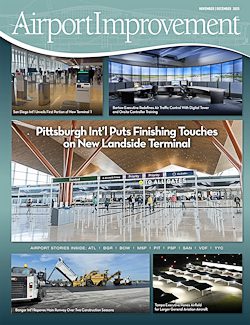Around the world, today’s passengers expect internet access when they travel—in the air and on the ground, from the start of their trip to the end. As more North American airports switch from paid internet access to free public Wi-Fi, the demand for faster and more secure networks continues to grow.
Early this year, Calgary Airports Authority and communications technology company TELUS entered into what the two entities call a groundbreaking 10-year deal to provide a high-performance 5G private wireless network across the campus of YYC Calgary Airport in Alberta. As the first airport in Canada to roll out a 5G private network, YYC is modernizing its infrastructure to support enhanced operations, providing a popular amenity for passengers and also benefiting airport employees and partners.
The private network will also help pave the airport’s path to the future by laying the foundation for key advances in operational technology for improved baggage scanning and tracking, perimeter security and eventually telematics.
| facts&figures
Project: Location: Cost: Airport declined to share Funding: Airport Timeline: Initial discussions started in 2023; contract awarded to provider in 2024; project completed March 2025 Telecommunications Provider: TELUS Key Benefits: Enhanced reliability, security & dedicated performance for critical operations like baggage handling, security systems & terminal operations |
“One of the terms we use quite a bit when we’re talking about the private network is ‘future-proofing’,” says Curtis Cameron, director of Information Management for Calgary Airports. “Not only is it good for our airport, it’s also good for other airports to learn from it. In the U.S., several larger airports like Houston or Miami have been using private networks for years; being the first in Canada is pretty exciting for us.”
More Connectivity, Less Cabling
Two years ago, TELUS facilitated a joint session with Calgary Airports and partners to discuss the “airport and airline of the future.”
“This meeting highlighted the critical need for a stronger foundational infrastructure to support digital innovation and AI automation, enabling the transition from today’s operations to tomorrow’s capabilities,” explains Jodi Baxter, vice president of Wireless, IoT and Industry Applications for the communications technology company. “TELUS was subsequently selected by the airport as its technology partner for its network modernization project.”
Throughout the years, YYC has repeatedly shown a commitment to technology for its passengers. The airport partnered with American Express to offer free public Wi-Fi in 2017, and in 2023 launched eduroam, a secure global Wi-Fi roaming service for students and researchers. This service connects participating wireless networks with the home server for authentication, providing users network access when visiting an institution other than their own.
Staff and tenants also benefited from the previous Wi-Fi network, but there are even more advantages for them with the new system.
“Of course, we have good connectivity within our terminal and outside of our terminal within a certain number of meters, but by getting a private wireless network we can provide productivity to the whole airfield,” Cameron says. “Right on the runway, for example, we have connectivity. When we’re loading bags into a plane, we can use our bag scanners and rely on wireless technology without extra cellular data charges.”
 As he and his team started investigating the benefits of a private network, they also realized it would help eliminate the vast amount of cabling required for many infrastructure projects. The cable and labor amounts to a huge cost, so avoiding more was another attractive advantage of a private network, Cameron explains.
As he and his team started investigating the benefits of a private network, they also realized it would help eliminate the vast amount of cabling required for many infrastructure projects. The cable and labor amounts to a huge cost, so avoiding more was another attractive advantage of a private network, Cameron explains.
With the proliferation of the Internet of Things—networking physical objects connected by sensors and software—YYC could see opportunities for more automation. The airport had already networked some airfield equipment, including baggage carts and tugs that contain laptops connected to cellular networks. Going forward, new laptops for staff will be fitted with subscriber identity module (SIM) chips to facilitate network access.
Another valuable use for the airport’s new private network is monitoring assets inside the terminal, such as elevators and escalators. If the connectors detect a maintenance issue, a message is automatically sent to the Operations Center—a more efficient process than staff patrolling the terminal and calling or radioing in service requests. The connected system proactively detects and tags equipment for maintenance or repair.
Speed Matters
TELUS describes YYC’s new onsite system as a dedicated, ultra-fast, low-latency secure network that lets devices connect smoothly using private LTE or 5G.
 Baxter explains that “ultra-fast” means data is transferred very quickly, and “low latency” means there is virtually no delay during the process of data transfer. “This is crucial for real-time applications such as video security systems, where a delay could compromise security, or for tracking baggage and equipment, where instant updates are essential for efficiency,” she elaborates. “To put it another way, instead of sharing a public road with everyone (which can get congested and slow), this network is your own private highway for all of your critical airport devices, ensuring consistent performance and reliability.”
Baxter explains that “ultra-fast” means data is transferred very quickly, and “low latency” means there is virtually no delay during the process of data transfer. “This is crucial for real-time applications such as video security systems, where a delay could compromise security, or for tracking baggage and equipment, where instant updates are essential for efficiency,” she elaborates. “To put it another way, instead of sharing a public road with everyone (which can get congested and slow), this network is your own private highway for all of your critical airport devices, ensuring consistent performance and reliability.”
Cameron notes that safety and security have long been priorities for the Calgary Airports Information Technology team, and the new private wireless network provides an additional layer of digital protection because it integrates with the airport’s firewalls. Nothing can be connected to the network without a physical or electronic SIM module, making it impossible to connect by hacking a password, Baxter explains. Currently, physical SIM cards are the only option, but eSIM will be available to YYC later this year. An eSIM is a digital version of a built-in SIM card that allows system administrators to activate a user without inserting a card into the device. It works by downloading a digital profile to the device’s embedded chip, which can be done via a quick-response code, a link from a carrier or software.
Scalable Future-Proofing
In Canada, there are three main telecommunications companies that provide network services: TELUS, Rogers and Bell. All three are well established across the country and offer related infrastructure and most of the needed equipment.
As Calgary Airports started to review its three options for a private wireless network, the IT team established some parameters for its requirements. Major criteria were service, cost and the ability to integrate all of its existing systems and networks. At that time, the airport was in the process of upgrading its distributed antenna system, which captures and distributes cellular signals throughout the terminal to provide wireless coverage for passengers and staff with minimal “dead spots.” The airport purchased what it describes as the “core,” a server configurated to connect the network within the airport’s property lines.

Having a private network helps the airport prepare for future technology changes.
Teams from TELUS and the airport met frequently at the beginning of the project, and then transitioned to weekly check-ins and later meeting every two weeks for major milestones. As the implementation date approached, they resumed weekly meetings.
“Every time we met with them, the risk register had pretty much nothing on it,” Cameron reports. “Our organizations worked well together.”
Return on Investment
Baxter emphasizes that an airport’s network isn’t just infrastructure; it’s the foundation of all operations. TELUS built YYC’s wireless network to ensure that the airport never has to choose between performance, security and support, she adds. On top of that, the network keeps 100% of user device data on-site with full local survivability capabilities, ensuring operations continue uninterrupted even when a user or device is isolated from external networks.
“Our private core infrastructure delivers up to 99.999 percent uptime,” Baxter specifies. “That ensures mission-critical applications and devices stay connected when it matters most.”
The new wireless network is also highly scalable, which speaks to the future-proofing technology Calgary Airports’ values.
If other airports have questions about the technology or process, Cameron encourages them to reach out. He has already spoken candidly about the project with a number of Canadian and U.S. airports, and welcomes more inquiries.
“I applaud our team at YYC and TELUS for working together on this project,” he says. “It was one of the smoothest projects in recent memory.”



